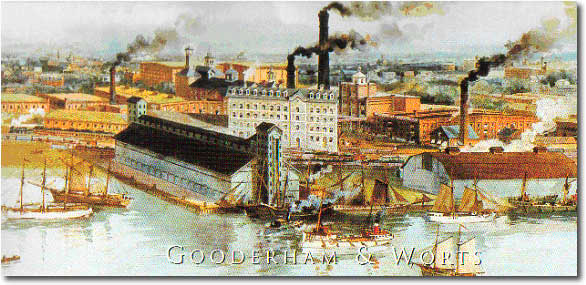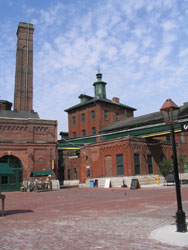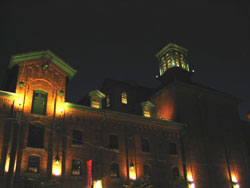|
November 10, 2005
T.O. History Revisited: The Gooderham and
Worts Factory Complex
By Bruce Bell
Bruce Bell is the history columnist for the Bulletin, Canada’s
largest community newspaper. He sits on the board of the Town of
York Historical Society and is the author of two books ‘Amazing
Tales of St. Lawrence Neighbourhood’ and ‘TORONTO: A
Pictorial Celebration’. He is also the Official Tour Guide
of St Lawrence Market. For more info visit brucebelltours.com
The Gooderham and Worts Distillery (Trinity and Mill St. in the
Parliament and Front St. vicinity) is without a doubt the best preserved
19th century factory complex in the country. What rescued its unparalleled
Victorian Industrial grandeur from being demolished, during the
riotous heyday of urban renewal in the 1960's, was the fact that
it kept functioning as a distillery up until the 1990's. Its walls
and cobblestone paths do not only encapsulate the surrounding neighborhood’s
lustrous history, but that too of Toronto, Canada and the British
Empire.
The first mill to be erected on that site was back in 1831, when
James Worts, a Yorkshireman, built a windmill with a millstone to
grind wheat into flour on the shores of what was then our waterfront.
That first mill-stone is today displayed prominently on a pedestal
on the grounds of the complex with a bronze plaque detailing its
history. In 1832 William Gooderham, also arriving from Yorkshire,
brought with him money and 54 family members to help his brother-in-law
expand the business, to be known then as Worts and Gooderham. One
of the first things they did was to replace the wind-powered sails
on the windmill with a steam engine after realizing the breeze off
the lake wasn't powerful enough.

In 1834 James Worts, despondent over the death of his wife in childbirth,
committed suicide. William Gooderham, together with his 7 sons (his
6 daughters, like other well-bred women of the 19th century, were
not encouraged to work) and the nephews left orphaned after the
death of his sister and James, took control of the factory and re-named
it Gooderham and Worts. The 'Worts' in the name of the factory is
not named for James Sr. but for his eldest son, James Gooderham
Worts, who took over his fathers' side of the business. Very few
of the 19th century books I use for part of my research ever mention
that James Worts committed suicide, it's only in the late 20th century
that this knowledge comes into print. What I can conclude however,
is that the people of early York looked upon James Worts as being
peculiar, a quixotic character, especially after he announced to
them he was going to build a windmill. Some 40 years after Worts'
death, James Beaty, an early pioneer, told friends that he came
upon Mr. Worts standing in the middle of the bush, on the site that
was to become the distillery, and was 'rambling on, apparently without
purpose'.
Mr. Beaty goes on to say 'Brooding inside Mr. Worts' brain seemed
to be a vision for what York was capable of becoming and a windmill,
though viewed as eccentric by the early upright citizens of York,
was to be just the beginning'. It would seem that James Worts was
a tortured man ahead of his time. Mr. Worts' Windmill, with its
non-functioning sails, was to become a cherished folly until it
was ultimately demolished in 1856 after being severely damaged in
a storm a few years before.
In 1837 the company began distilling the wheat by-products into
booze for a thirsty city. Toronto for all it's soon to be Victorian
idealism and demeanor was a saloon-laden town with a tavern for
every 100 people. Beer was drunk then, like water is today. Mothers
fed their babies beer, kids drank beer openly in the streets, magistrates
and clergy drank on the job and no wonder, water then was filthy
and tasted horrible. Dead horses, cats, dogs, manure and daily garbage
were thrown onto the ice of Lake Ontario and when the ice melted,
the sewage would sink into the lake where upon people would drink
the stuff untreated. That in turn led to cholera outbreaks, killing
thousands. Beer seemed a nice alternative to death.
The 45 structures that today make up the factory site were begun
in 1859; the oldest being the gray limestone gristmill and distillery
that can be seen from the Gardiner Expressway. It, like the windmill
had been, became a landmark at the eastern end of the harbour.

Modern view of the Distillery District
The building was state-of-the-art when built. It housed an elevator
on the south side that raised grain from rail-cars to the upper
floors. At its eastern end was a 100-horsepower steam engine that
ran eight sets of grindstones and the western end held the distillery
apparatus. The noise inside must have been deafening. Under the
supervision of architect David Roberts Sr., five hundred men worked
on the construction, with four massive lake schooners being used
to move the stone from Kingston quarries. The building was finished
in 1860, at a cost of a then staggering sum of 25,000 dollars, making
it the most expensive building project in Toronto at the time. In
1863 the malting and storage buildings, the ones with the cupolas
rising from their roofs, and the massive square shaped warehouse
(now used as storage for The City of Toronto) at the corner of Trinity
and Mill Streets, were built.
In 1869 a keg of benzine broke open that caused a huge explosion
and fire to spread up the elevator shaft of the main building destroying
the wooden interior (later re-built) but left the gray limestone
exterior standing.
In 1870, the Pure Spirits Building, one of the most charming buildings
Toronto has left from this period, was built. Made of red brick,
it has French doors leading out onto a wrought iron balcony on its
second floor.
Solid brick piers or buttresses, used to support tall panels of
plate glass, rise above the roof, the building was used for processing
extremely flammable pure alcohol and the west-facing glass wall
admitted as much natural light as possible thus eliminating the
need for open gas jet lamps.
Three events of the mid 19th century inspired the tremendous growth
of Toronto and the financial boom of the Gooderham and Worts family
fortunes. The first was the Great Fire of 1849 that destroyed much
of then downtown Toronto and resulting in the rebuilding of the
city, as we know it today. The second was the coming of the railroad,
which made for easier access of products streaming in and out of
the city.
The third was a fungus which ruined the crop of potatoes that sustained,
however meager, the people of Ireland. Toronto's population swelled
with starving Irish refugees escaping the horrors of the Great Potato
Famine back home. Toronto had, before these events, a small population
of about 10,000, mostly of British Protestant descent. By 1851 the
population grew to 30,000, with 37% being Irish. They worked mostly
as servants and as labourers in the many mills, including Gooderham
and Worts that sprang up along the Don River.

Distillery District at night
The newly arrived Irish, both Catholic and Protestant, settled
into the area surrounding King and Parliament Streets just up the
road from the Distillery. This area was to expand northwards and
because of the cabbages that were grown in abundance it came to
be known as Cabbagetown. In 1985 JMS Careless wrote in- Gathering
Place, People and Neighbourhoods of Toronto- of Cabbagetowns’
beginnings....'Blight stemmed from the dirt, debris and fumes of
factories close at hand; their industrial dumps and coal-heaps not
to mention stockyards, livery stables, cow-barns and all their refuse.
Other major offenses were the reeking hog pens of the big William
Davies meat packing plant and the cattle herded at Gooderham and
Worts to feed on used brewing mash. All this and the dangers of
choked privies, overflowing cesspools and contaminated wells in
a district thinly served by the civic water system.' Yuck!
In 1843 William Gooderham, built the Little Trinity Church on King
E because at the time St. James Cathedral at King and Church used
to charge a pews fee and many working class Anglicans couldn't afford
to pay it. The Catholics too had their own Church, St. Paul's, on
Power and Queen E, built in 1826 and re-built in 1887 as the magnificent
St. Paul's Roman Catholic Church that stands there now. As their
fortunes grew the Gooderhams, beginning in 1885, started to build
worker-cottages on Trinity and Sackville Streets (still standing)
but they weren't the only benevolent distilling family in the district.
In 1848 the Protestant Irish of this neighbourhood were too poor
to send their children to the up-scale school at St. James and free
education was years off, so brewer Enoch Turner built what is today
the oldest standing school building in the city, The Enoch Turner
School House on Trinity Street.
There it was, a perfect English-style factory town, stench and
all, on the edge of a great city. What more could a working man
want? Home, factory, school, church and tavern all within walking
distance. The Gooderhams, with all their wealth and power continued
to live amongst their workers in a house, now demolished, on the
NW corner of Trinity and Mill Streets.
In the late 1800's as Toronto was becoming more class conscience
and the dividing lines between commercial and residential areas
became more defined,
George Gooderham, son of William, who had now taken over the family
business, built for himself an impressive mansion (still standing)
in the fashionable Annex area on the NE corner of Bloor and St.
George in 1889.
George, now in full control of the family business, developed it
into a financial and commercial empire becoming not only the richest
man in Toronto but in all of Ontario. As the distillery flourished
he enlarged its facilities and began to expand his own interests
that included the Toronto and Nipissing Railroad, Manufactures’
Life Insurance, The King Edward Hotel and philanthropic enterprises
like U of T and The Toronto General Hospital. In 1882 he became
the president of The Bank of Toronto (forerunner to The TD). What
he needed now was an impressive office building. In 1891 he commissioned
David Roberts Jr., the son of the architect who had built the distillery,
to erect what is today the crown jewel and the most photographed
structure in our neighbourhood, the Gooderham Building, also known
as the Flatiron at the junction of Church, Front and Wellington
Streets (today owned and lovingly restored by Anne and Michael Tippin).
There, on the fifth floor, underneath the green cone-shaped cupola,
he set himself up in an office that overlooked not only the busy
intersection below but also everything and everyone he held command
of, the original Big Brother. From the ships in the Harbour and
the trains on the Esplanade, to the Distillery in the distance,
all were within his sight. Then he had commissioned, what was to
become one of the great legends of our neighbourhood, a tunnel to
pass underneath Wellington Street to connect with the Bank of Toronto
(where Pizza-Pizza now stands). Even though it's been bricked up
at both ends and cable, phone and sewer lines criss-cross it, Mr.
Gooderham's tunnel still exists.
When he died in 1905 his funeral at St. James Cathedral, against
his last wishes for a small affair, was one of the largest the city
had seen. He was a great benefactor, builder and much loved man
to the people of Toronto who lined the streets to show their respect
as his cortege made its way to St. James Cemetery.
In 1920, the distillery, founded by 'the famous Mr. Gooderham as
he was commonly known, and by the tragic Mr. Worts, was bought by
the Hiram Walker Company. Today its ultimate fate still hangs in
the air, with condos, apartments and lofts springing up around it,
the Gooderham and Worts complex is used mostly as a film set and
no wonder, it's Old World ambiance and Hollywood-back-lot atmosphere
is picture perfect. To walk around within its enclave, when no one
is around as I did recently, is to journey to another era. You can
just make out through the centuries old dust that is the mist of
time, the young 19th century immigrant, standing before its main
gates, lunch box in hand, about to enter his first day on the job,
not knowing what to expect from this new world that lay before him.
With that kind of history, could there be a more perfect place for
a much needed Toronto Museum?
[Editor's note: This article was originally written some time
ago. Since then the Historic Distillery District has recently become
one of the most vibrant entertainment areas in Toronto, with restaurants,
breweries, galleries, book stores and artisans' workshops. More
info is available at http://www.thedistillerydistrict.com/htmlsite/index.html]
Useful Books:
Here is Bruce's brand-new book about Toronto
Related Articles:
Here's my story about Bruce Bell's St.
Lawrence Market Tour
Bruce's history of Toronto Island
- Part I
Bruce's history of Toronto Island
- Part II
Bruce's history of Toronto's St.
James Cathedral
Bruce's history of The Royal
York Hotel
|